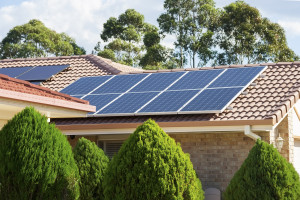By Adriana Espinosa, BDX
Looking for clean and sustainable energy? Look no further than the sun.
Many homeowners look into solar panels in an effort to source clean energy to power their homes. The added benefit of lower utility costs make solar panels a lucrative option for homeowners interested in saving.
With dates tracing back to 1876, solar power is not a new concept, but it has not been until recently that solar energy has hit mainstream news. With the help of recent price reductions, tax incentives, and faster installation, solar panels are becoming a more feasible option for residential use than ever before.
The advantages are clear – clean energy for cheaper. Recent numbers show that solar installation costs have already dropped 73 percent since 2006. With costs continually dropping, PV installation increased 41 percent in 2013.
As the interest for solar reaches new heights, nationally-acclaimed builders are taking notice.
Solar Impacts Housing Industry
With the solar industry growing 34 percent and its residential division growing 51 percent during 2013, the housing industry has been affected dramatically. Home builders now have the advantage to include solar panels in the construction of their homes.
Lennar for instance, now offers the option of solar panel installation during construction. As Kris Hudson from the Wall Street Journal reports, it is cheaper to install solar panels during the construction phase of a home than retrofitting an existing home with solar panels.
Lennar is not the only builder taking advantage of this opportunity. Home builders KB Home and Meritage Corp. are joining the solar effort by offering their own solar panel options as well. It is clear home builders have much to gain from the solar industry.
No Huge Rush for Solar Quite Yet
In an effort to measure the influence of solar energy on current home decisions, BDX used its New Home Shopper Insights focus group to gain leads into what the housing market is really thinking.
The Home Insights panel expressed that despite the advantages of solar power, many homeowners are hesitant to invest in them because they feel the upfront costs are too great to consider, and their return will not be profitable.
New Home Shopper panelist, Christine from Michigan, expresses her reluctance for solar panels: “I love the idea of solar panels, and I would be very interested in getting some for our house. What is holding us back is the price tag on the purchase and installation. We feel like we would not get a good enough return on them.”
Ricky, a resident of Arizona, expresses similar reservations: “They can be a great thing if you live in a place with lots of sun like here in Arizona. The issues that come up though are the cost to install and maintain them once they are in place. Some people qualify for rebates and other discounts while others with older homes do not. I have thought about using them myself but the issue is with the rebates. (They) just cost too much to put in.”
With 2014’s top solar states spreading all over the map from California, Texas, New York, and Hawaii, the evident uncertainty in solar panels could be a result of the fluctuating installation costs due to varying rates dependent on the geographic area of homeowners.
Measuring the Cost of Solar Panels
According to HGTV’s True Cost of Solar Power, shoppers need to start with a budget to determine how much of their house will be converted to solar energy. With this, the appropriate system can be installed. Before federal and local tax incentives are deducted, the initial cost of solar panels can go up towards $50,000 for a 6.25 kWh system.
Factoring in the average payback period ranges from 5 to 10 years, it is clear why many homeowners might be reluctant to invest in solar panels right now.
Making Solar Energy More Affordable
The missing link to making solar panels more affordable might be the financing options available to those interested.
As reported by Planet Money’s How Solar Got Cheap, Solar City, a major solar energy company that installs solar panels for residential use, provides a payment option where residents do not have to shell out tens of thousands of dollars in upfront costs. Solar City offers a 20-year contract where homeowners pay their solar panels in monthly payments.
How does this work? As Jacob Goldstein and David Kestenbaum from Planet Money explain, Solar City owns the solar panels, and homeowners pay Solar City for using them in monthly cycles over the course of 20 years resulting in savings of around 40-50 percent.
Similar to Solar City, Lennar also offers financing options for its buyers. Lennar gives prospects the option to purchase solar panels or rent the system and pay for the power generated from them through Lennar’s affiliated party, SunStreet Energy Group. Its 20-year leasing agreement guarantees savings of 20 percent every month.
While the 20-year cost may exceed the initial upfront cost of installation, depending on the geographic area, it does make paying for solar energy more manageable by eliminating expensive initial costs.
The Future of Solar Energy
While solar technology continues to grow, companies have jumped in to expand the reach of solar energy.
Recently, Tesla’s Powerwall made news as Tesla Motors endeavors to get homes completely off the utility grid by supplementing solar panels with house batteries that can store solar energy harnessed from the solar panels creating even greater savings.
With processing speed doubling every two years, sooner or later more homes will be equipped with solar panels. Even the White House has installed solar panels.
It is vital for builders to remain in the lead of the current market trends for solar power. Considering the momentous growth rate of solar energy, the time for builders to provide solar energy for prospective homeowners has never been better.
Builders interested in conducting research through the New Home Shopper Insights panel can get more information by contacting Info@theBDX.com.


